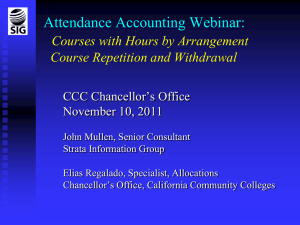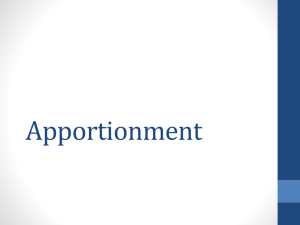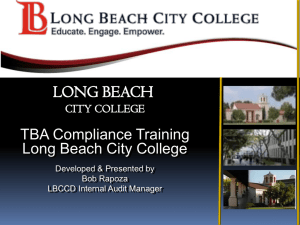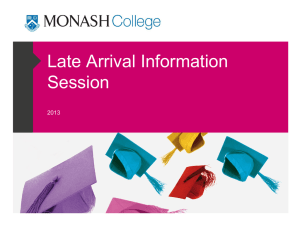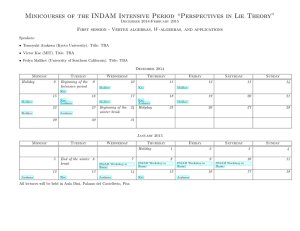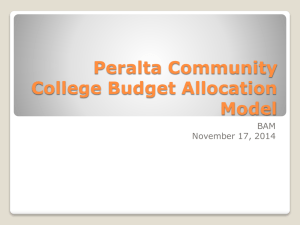Current Activities
advertisement
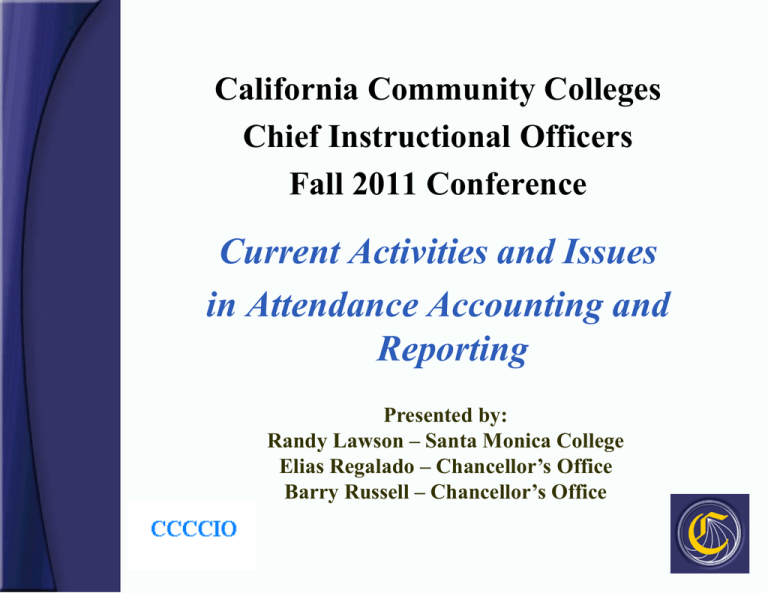
California Community Colleges Chief Instructional Officers Fall 2011 Conference Current Activities and Issues in Attendance Accounting and Reporting Presented by: Randy Lawson – Santa Monica College Elias Regalado – Chancellor’s Office Barry Russell – Chancellor’s Office AGENDA What is the Apportionment Attendance Report (CCFS-320) and what is it used for? Basic Requirements for Reporting Courses and other Conditions Affecting Apportionment Conditions Current Activities – Auditing Clarification of Critical Areas in Attendance Accounting and Reporting (CDAM Item No. 424). What are the auditors and districts finding? – To Be Arranged (TBA) Hours Review (CDAM Item No. 479) AGENDA (cont.) Current Activities (cont.) – Course Repetition and Withdrawal Title 5 Changes • Effect of New Enrollment Limits (Title 5 Section 58161) – Emergency Conditions Request – CCFS-313 Chancellor’s Office Website Overview Questions/Comments * Unless otherwise indicated, all legal citations refer to California Code of Regulations, Title 5 Apportionment Attendance Report (CCFS-320) Required by Title 5 Section 58003.4 Prepared in accordance with deadlines and instructions prescribed by the Chancellor’s Office The Chancellor’s Office calculates the amount of State General Apportionment funds, based primarily on the number of FTES workload that districts report on the CCFS-320 Requirements for Reporting Course FTES on the CCFS-320 The basic conditions or standards for claiming FTES are provided by Title 5 § 58050, which include provisions related to: – Appropriate course/program approval – Open enrollment – Full-funding/compensation prohibitions (double dipping) – Appropriate educational activities as described in the course outline of record – Contact hours claimed for apportionment must be consistent with those indicated in the course outline of record – Immediate supervision and control of an appropriate academic employee of the district that holds valid and unrevoked credentials or be employed pursuant to minimum qualifications – Other conditions affecting apportionment eligibility apply Requirements for Reporting Course FTES on the CCFS-320 Consistent with Title 5 § 58050, the basic attendance accounting requirements are intended to promote the following purposes: – To ensure effectiveness of instruction – To ensure that state aid is apportioned according to the same standards to all districts – To ensure the safety of students – To ensure that the state, districts, and students receive a reasonable return for monies expended Requirements for Reporting Course FTES on the CCFS-320 Districts are required to establish procedures and policies that will assure that FTES reported for State Apportionment purposes meet all requirements of law Documentation requirements have been developed to promote standardized, accurate reporting of data, and to facilitate audits of related community college records Documentation is based on detailed tabulations of course sections and appropriate support records Auditing Clarification Auditing Clarification of Critical Areas in Attendance Accounting and Reporting (2010-11 CDAM Item No. 424) Intended to enhance consistency in the Annual Audit in the area of attendance accounting and reporting Provided training to auditing firm representatives on August 27 and to Districts on August 2 Auditors are asked to apply new auditing clarification to FY 2010-11, but must also certify certain audit conditions for FY 2009-10 Significant focus placed on Catalog hours vs. Scheduled Hours issue Auditing Clarification Auditors specifically asked to verify that: district maintains and follows appropriate local governing board adopted attendance accounting procedures required tabulations are maintained for each course section and that attendance records are appropriately maintained the district uses appropriate attendance accounting procedure for courses claimed for apportionment courses are appropriately scheduled and contact hours are computed in accordance with applicable requirements the district has secured, as applicable, Chancellor’s Office / local governing board / curriculum committee approval for credit and noncredit courses claimed for apportionment What are the Auditors and Districts Finding? Various problems with the application of the TBA Hours scheduling option Course scheduling not consistent with hours indicated in the official course outline of record Incorrect attendance accounting procedure utilized No supporting documentation to verify census rosters are cleared of inactive enrollment Apprenticeship hours of Related and Supplemental Instruction (RSI) incorrectly reported on CCFS-320 Courses fully funded via Contract Education incorrectly reported on CCFS-320 What are the Auditors and Districts Finding? Flexible Calendar implementation problems Course contact hours based on catalog/course outline target hours instead of contact based on schedule of classes Classification issues related to student residency for tuition purposes Local holidays that impact apportionment eligibility Instructional Services Agreements (ISA’s) issues that impact apportionment eligibility 2010-11 Audit Reports due December 31 - We’ll know more after these reports are reviewed To Be Arranged (TBA) Hours TBA Definition Some Courses with regularly scheduled hours of instruction have “hours to be arranged” (TBA) as part of the total contact hour for the course. The TBA portion of the course uses an alternate method for regularly scheduling a credit course for purposes of applying either the Weekly or Daily Census attendance accounting procedures. In some situations, the entire course might be on TBA, and in that case this course would follow the same rules. New Audit Compliance Item for 2010-11 Item No. 479 To Be Arranged (TBA) Hours Basic Rules for Courses with TBA Hours Instructors must meet applicable minimum qualifications or equivalency The official course outline must include the number of TBA hours and specific instructional activities/learning outcomes expected of all enrolled students Students must be informed of these activities and expectations Instruction must be provided during TBA hours that is NOT an activity that should be done independently outside of class time Students must still be required to study independently outside of class time To Be Arranged (TBA) Hours Basic Rules for Courses with TBA Hours (cont.) A clear description of the course, including the number of TBA hours, must be published in the catalog and schedule of classes (in print and/or online) Students must be informed of the designated location where instructional activities during TBA hours will occur Days, times, and number of TBA hours attended by each student must be recorded by sign in/sign out on paper or electronically and available for audit An instructor meeting the minimum qualifications must be present during all TBA hours, even if assisted by an instructional aide To Be Arranged (TBA) Hours Attendance Accounting and Reporting for TBA Hours The course outline of record must specify the number of required contact hours as a whole, including TBA hours Contact hours claimed for apportionment must be consistent with the course outline of record If a course reported for apportionment includes TBA hours, documentation is required to demonstrate that each student claimed for apportionment has completed the minimum TBA requirement Apportionment for TBA hours cannot be claimed for students who have documented zero TBA hours of attendance as of the census date of the class To Be Arranged (TBA) Hours Attendance Accounting and Reporting for TBA Hours For Weekly Census classes, TBA hours must be scheduled for the same number of hours each week. Student TBA schedules may be fixed or variable, but the required hours must be completed each week. For Daily Census classes, TBA hours must be scheduled for the same number of hours on each scheduled day. Student TBA schedules may be fixed or variable, but the required hours must be completed each day the class meets TBA hours are therefore impractical for most Daily Census classes, and hence present a challenge for summer classes If TBA hours are not scheduled as required, attendance for the entire course must be reported as Actual Hours of Attendance (Positive Attendance) To Be Arranged (TBA) Hours Reference Documents To Be Arranged (TBA) Hours Compliance Advice (Legal Advisory 08-02), October 1, 2008 To Be Arranged (TBA) Hours Follow-up Memorandum, January 26, 2009 To Be Arranged (TBA) Hours Follow-up Memorandum, June 10, 2009 Contracted District Audit Manual for 2010-11, Item No. 479 Title 5 Changes – Effect of New Apportionment Limits for Enrollment in Credit Courses New regulations adopted by Board of Governors on July 11, 2011 for apportionment limits for enrollment in credit courses Effective date of the new regulations is October 12, 2011 Districts are expected to fully implement with appropriate policy changes and public notice in time for Summer 2012 Title 5 Changes – Effect of New Apportionment Limits for Enrollment in Credit Courses New definition of enrollment for apportionment purposes: An enrollment occurs only when a student receives an evaluative or nonevaluative symbol for the course. (§ 58161) Apportionment claims for a student are limited to enrollments in a maximum of three semesters or five quarters in a credit course, including any combination of withdrawals and repetitions (§ 58161(a)) Apportionment for one additional enrollment can be claimed for certain exceptions: Significant lapse of time (§ 55043) Extenuating circumstances (§ 55045) Title 5 Changes – Effect of New Apportionment Limits for Enrollment in Credit Courses Per § 58161(c), no apportionment limitation for: Legally mandated training (§ 55041(b)) Disability-related accommodation in special classes (§ 56029) Variable Unit Open Entry/Open Exit, to the extent permitted by § 55044 Cooperative work experience courses, to the extent permitted by § 55253 Withdrawals resulting from extraordinary conditions (§ 55024(a)(10)) Military withdrawals (§ 55024(d)(1)) Title 5 Changes – Effect of New Apportionment Limits for Enrollment in Credit Courses New enrollment limits only apply to credit courses NOT designated as “repeatable” Enrollment limits for “repeatable” courses continue as they were prior to the adoption of the new regulations limits (§ 58161(d); 55041(c)) District policy must limit “W’s” for the same course to a number not greater than three (§ 55024(a)(9)) District may permit enrollment in credit courses beyond the stated limits, but such enrollments may not be claimed for apportionment (§ 58161(e)) Title 5 Changes – Effect of New Apportionment Limits for Enrollment in Credit Courses All prior credit course repeats and withdrawals in student’s academic record will count toward the new limit Students’ decisions to repeat or withdraw from courses will have more implications under the new policies Colleges should provide guidance to students so they can make informed enrollment and withdrawal choices Title 5 Changes – Effect of New Apportionment Limits for Enrollment in Credit Courses Colleges should begin now to train counselors, advisors, and other faculty so they can explain changes to students as they consider plans to enroll in or withdraw from courses Districts will need to modify programming, catalogs, and other college information given to students to reflect the new apportionment limits Title 5 Changes – Effect of New Apportionment Limits for Enrollment in Credit Courses Reference Documents October 12, 2011 Follow-up Advisory Regarding New Title 5 Apportionment Limits for Credit Course Enrollment, Repetition and Withdrawal September 12, 2011 Advisory Regarding Title 5 Repetition and Withdrawal from Credit Courses Full Regulations as filed with the Secretary of State Future Chancellor’s Office implementation guidance Current Activities FTES Allowances Due to Emergency Conditions Title 5 § 58146 provides the criteria for FTES allowances due to emergency conditions Emergency Conditions Request (CCFS-313, § 58146) Only material decreases in FTES resulting from an emergency condition are eligible for an attendance allowance In most cases, only positive attendance FTES is affected Chancellor’s Office Website Web Address: www.cccco.edu – Primary Source for: • • • • • • • Board of Governors & Consultation Council Information Notices of Recently Promulgated Title 5 Regulations and Implementation Guidelines Legal Advisories/Opinions Legal Resources (direct links to Title 5 and EC) Handbooks and Manuals Fiscal/FTES Data Contact Information Questions/Comments Contact Information Randy Lawson – Santa Monica College (310) 434-4360 lawson_randal@smc.edu Elias Regalado – Chancellor’s Office (916) 445-1165 eregalad@cccco.edu Barry Russell – Chancellor’s Office (916) 322-6886 brussell@cccco.edu
